Understanding China's National Culture: Implications for Business
VerifiedAdded on 2023/06/12
|6
|1396
|306
Report
AI Summary
This report examines China's national culture within the context of globalization, focusing on its impact on business and employees. It uses models like Edward T. Hall's high-context culture framework to differentiate Chinese cultural values and communication styles. The report highlights how understanding these cultural nuances is crucial for multinational companies like McDonald's when entering the Chinese market. It emphasizes the importance of considering organizational culture, customer preferences, and communication styles to ensure successful business operations and partnerships. The analysis covers aspects such as collectivism, long-term commitment, and the significance of group harmony in Chinese society, providing insights for global organizations aiming to operate effectively in China. Desklib offers a platform for students to access this assignment along with a wide range of study resources, including past papers and solved assignments.
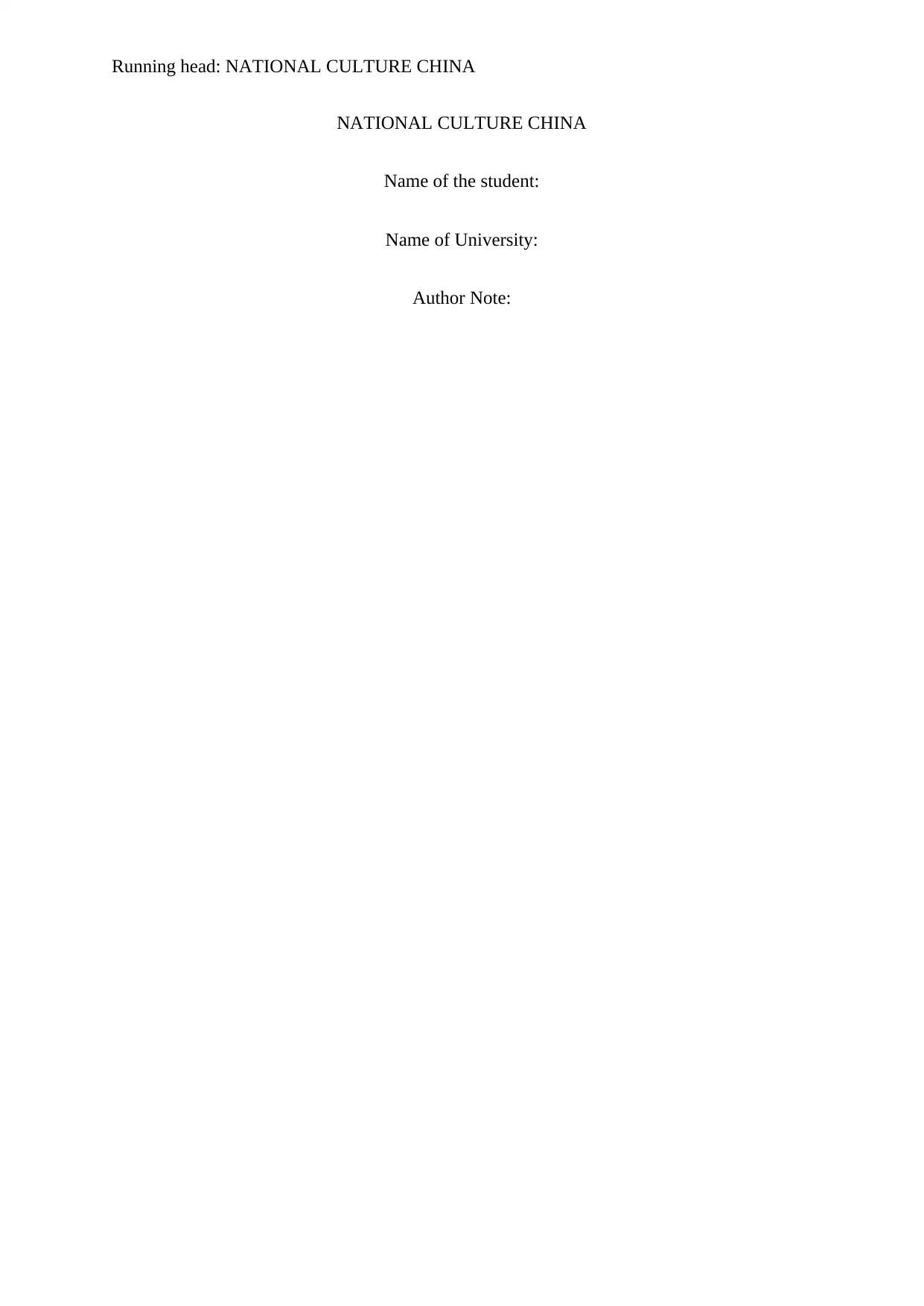
Running head: NATIONAL CULTURE CHINA
NATIONAL CULTURE CHINA
Name of the student:
Name of University:
Author Note:
NATIONAL CULTURE CHINA
Name of the student:
Name of University:
Author Note:
Paraphrase This Document
Need a fresh take? Get an instant paraphrase of this document with our AI Paraphraser
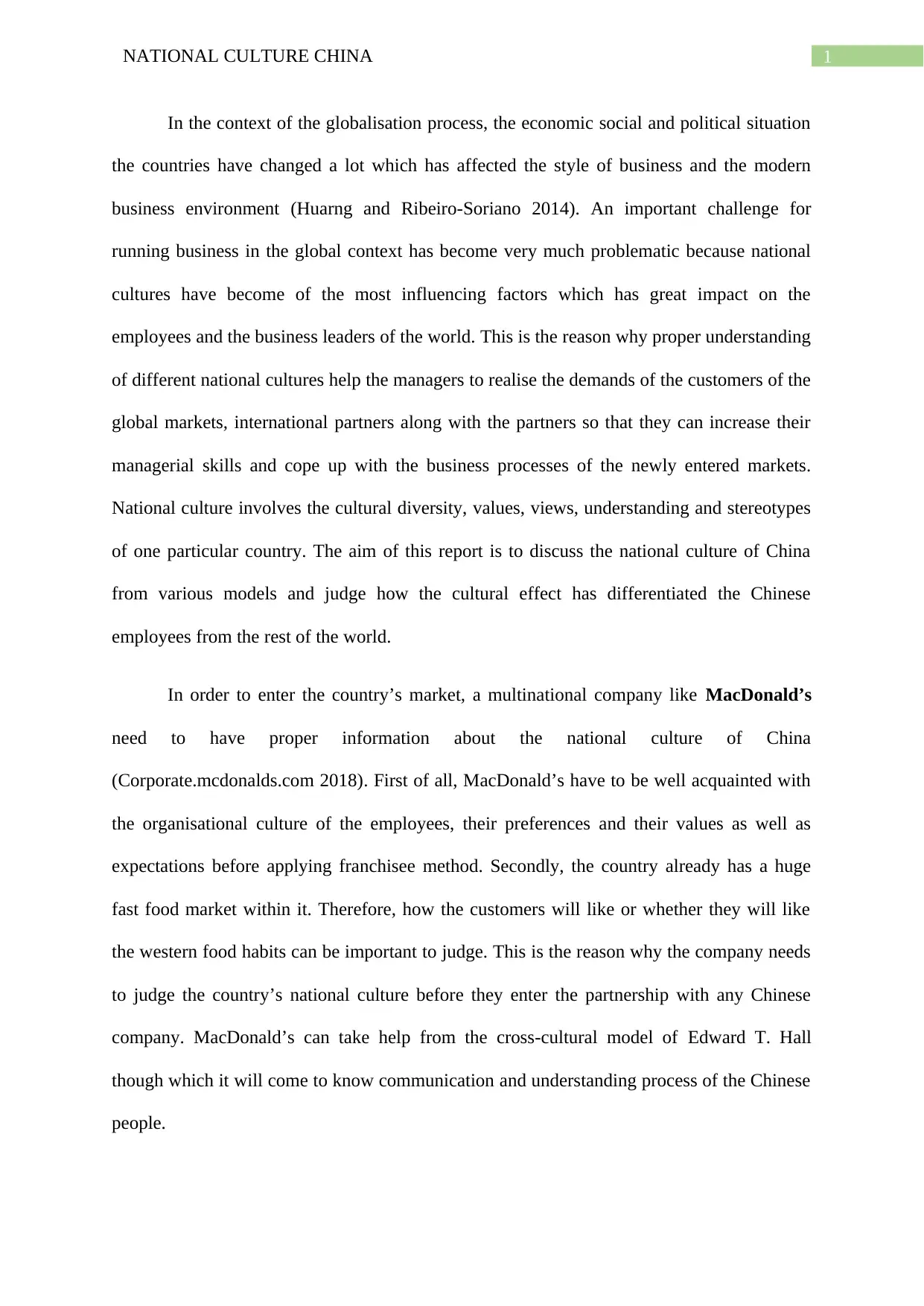
1NATIONAL CULTURE CHINA
In the context of the globalisation process, the economic social and political situation
the countries have changed a lot which has affected the style of business and the modern
business environment (Huarng and Ribeiro-Soriano 2014). An important challenge for
running business in the global context has become very much problematic because national
cultures have become of the most influencing factors which has great impact on the
employees and the business leaders of the world. This is the reason why proper understanding
of different national cultures help the managers to realise the demands of the customers of the
global markets, international partners along with the partners so that they can increase their
managerial skills and cope up with the business processes of the newly entered markets.
National culture involves the cultural diversity, values, views, understanding and stereotypes
of one particular country. The aim of this report is to discuss the national culture of China
from various models and judge how the cultural effect has differentiated the Chinese
employees from the rest of the world.
In order to enter the country’s market, a multinational company like MacDonald’s
need to have proper information about the national culture of China
(Corporate.mcdonalds.com 2018). First of all, MacDonald’s have to be well acquainted with
the organisational culture of the employees, their preferences and their values as well as
expectations before applying franchisee method. Secondly, the country already has a huge
fast food market within it. Therefore, how the customers will like or whether they will like
the western food habits can be important to judge. This is the reason why the company needs
to judge the country’s national culture before they enter the partnership with any Chinese
company. MacDonald’s can take help from the cross-cultural model of Edward T. Hall
though which it will come to know communication and understanding process of the Chinese
people.
In the context of the globalisation process, the economic social and political situation
the countries have changed a lot which has affected the style of business and the modern
business environment (Huarng and Ribeiro-Soriano 2014). An important challenge for
running business in the global context has become very much problematic because national
cultures have become of the most influencing factors which has great impact on the
employees and the business leaders of the world. This is the reason why proper understanding
of different national cultures help the managers to realise the demands of the customers of the
global markets, international partners along with the partners so that they can increase their
managerial skills and cope up with the business processes of the newly entered markets.
National culture involves the cultural diversity, values, views, understanding and stereotypes
of one particular country. The aim of this report is to discuss the national culture of China
from various models and judge how the cultural effect has differentiated the Chinese
employees from the rest of the world.
In order to enter the country’s market, a multinational company like MacDonald’s
need to have proper information about the national culture of China
(Corporate.mcdonalds.com 2018). First of all, MacDonald’s have to be well acquainted with
the organisational culture of the employees, their preferences and their values as well as
expectations before applying franchisee method. Secondly, the country already has a huge
fast food market within it. Therefore, how the customers will like or whether they will like
the western food habits can be important to judge. This is the reason why the company needs
to judge the country’s national culture before they enter the partnership with any Chinese
company. MacDonald’s can take help from the cross-cultural model of Edward T. Hall
though which it will come to know communication and understanding process of the Chinese
people.
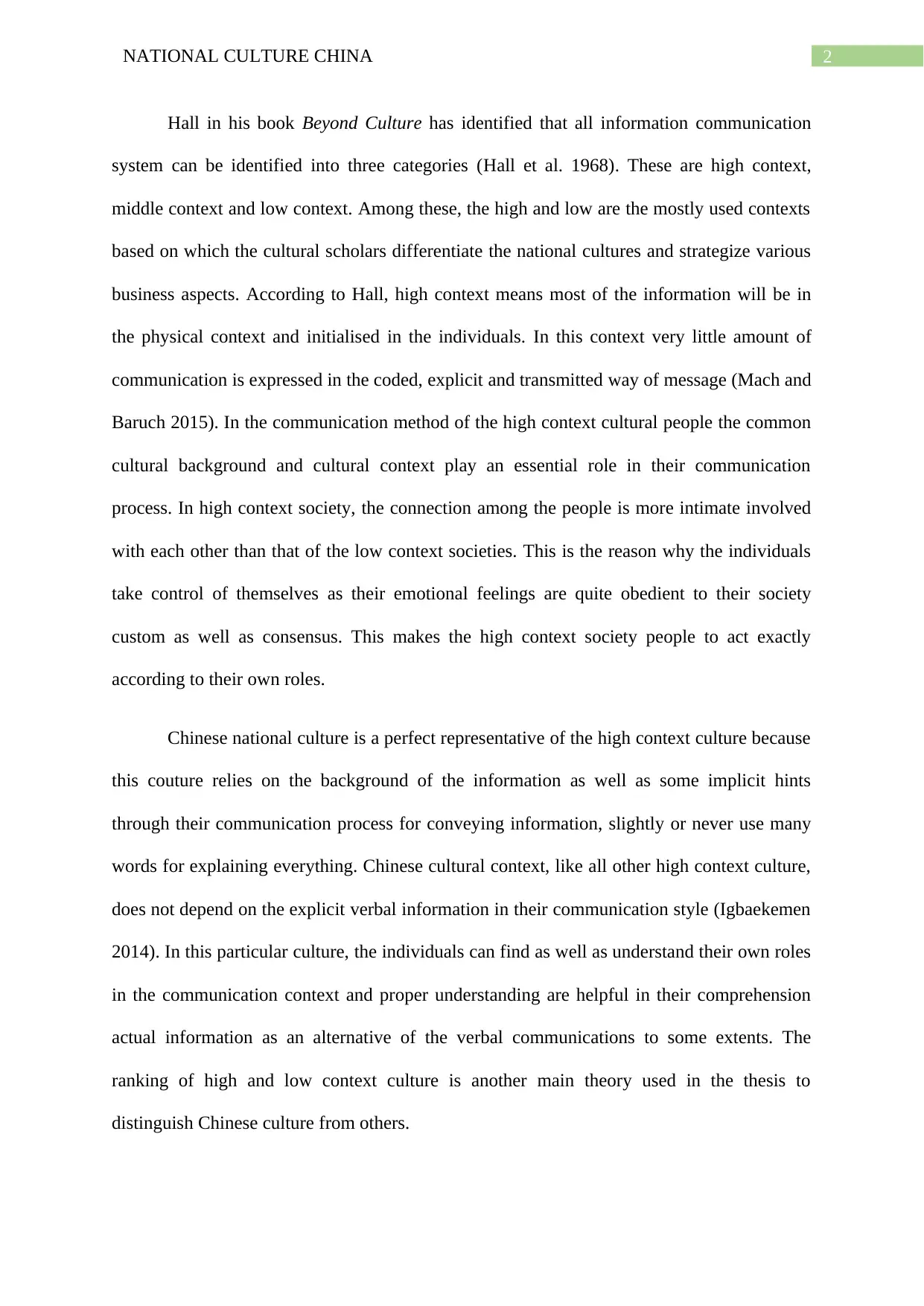
2NATIONAL CULTURE CHINA
Hall in his book Beyond Culture has identified that all information communication
system can be identified into three categories (Hall et al. 1968). These are high context,
middle context and low context. Among these, the high and low are the mostly used contexts
based on which the cultural scholars differentiate the national cultures and strategize various
business aspects. According to Hall, high context means most of the information will be in
the physical context and initialised in the individuals. In this context very little amount of
communication is expressed in the coded, explicit and transmitted way of message (Mach and
Baruch 2015). In the communication method of the high context cultural people the common
cultural background and cultural context play an essential role in their communication
process. In high context society, the connection among the people is more intimate involved
with each other than that of the low context societies. This is the reason why the individuals
take control of themselves as their emotional feelings are quite obedient to their society
custom as well as consensus. This makes the high context society people to act exactly
according to their own roles.
Chinese national culture is a perfect representative of the high context culture because
this couture relies on the background of the information as well as some implicit hints
through their communication process for conveying information, slightly or never use many
words for explaining everything. Chinese cultural context, like all other high context culture,
does not depend on the explicit verbal information in their communication style (Igbaekemen
2014). In this particular culture, the individuals can find as well as understand their own roles
in the communication context and proper understanding are helpful in their comprehension
actual information as an alternative of the verbal communications to some extents. The
ranking of high and low context culture is another main theory used in the thesis to
distinguish Chinese culture from others.
Hall in his book Beyond Culture has identified that all information communication
system can be identified into three categories (Hall et al. 1968). These are high context,
middle context and low context. Among these, the high and low are the mostly used contexts
based on which the cultural scholars differentiate the national cultures and strategize various
business aspects. According to Hall, high context means most of the information will be in
the physical context and initialised in the individuals. In this context very little amount of
communication is expressed in the coded, explicit and transmitted way of message (Mach and
Baruch 2015). In the communication method of the high context cultural people the common
cultural background and cultural context play an essential role in their communication
process. In high context society, the connection among the people is more intimate involved
with each other than that of the low context societies. This is the reason why the individuals
take control of themselves as their emotional feelings are quite obedient to their society
custom as well as consensus. This makes the high context society people to act exactly
according to their own roles.
Chinese national culture is a perfect representative of the high context culture because
this couture relies on the background of the information as well as some implicit hints
through their communication process for conveying information, slightly or never use many
words for explaining everything. Chinese cultural context, like all other high context culture,
does not depend on the explicit verbal information in their communication style (Igbaekemen
2014). In this particular culture, the individuals can find as well as understand their own roles
in the communication context and proper understanding are helpful in their comprehension
actual information as an alternative of the verbal communications to some extents. The
ranking of high and low context culture is another main theory used in the thesis to
distinguish Chinese culture from others.
⊘ This is a preview!⊘
Do you want full access?
Subscribe today to unlock all pages.

Trusted by 1+ million students worldwide
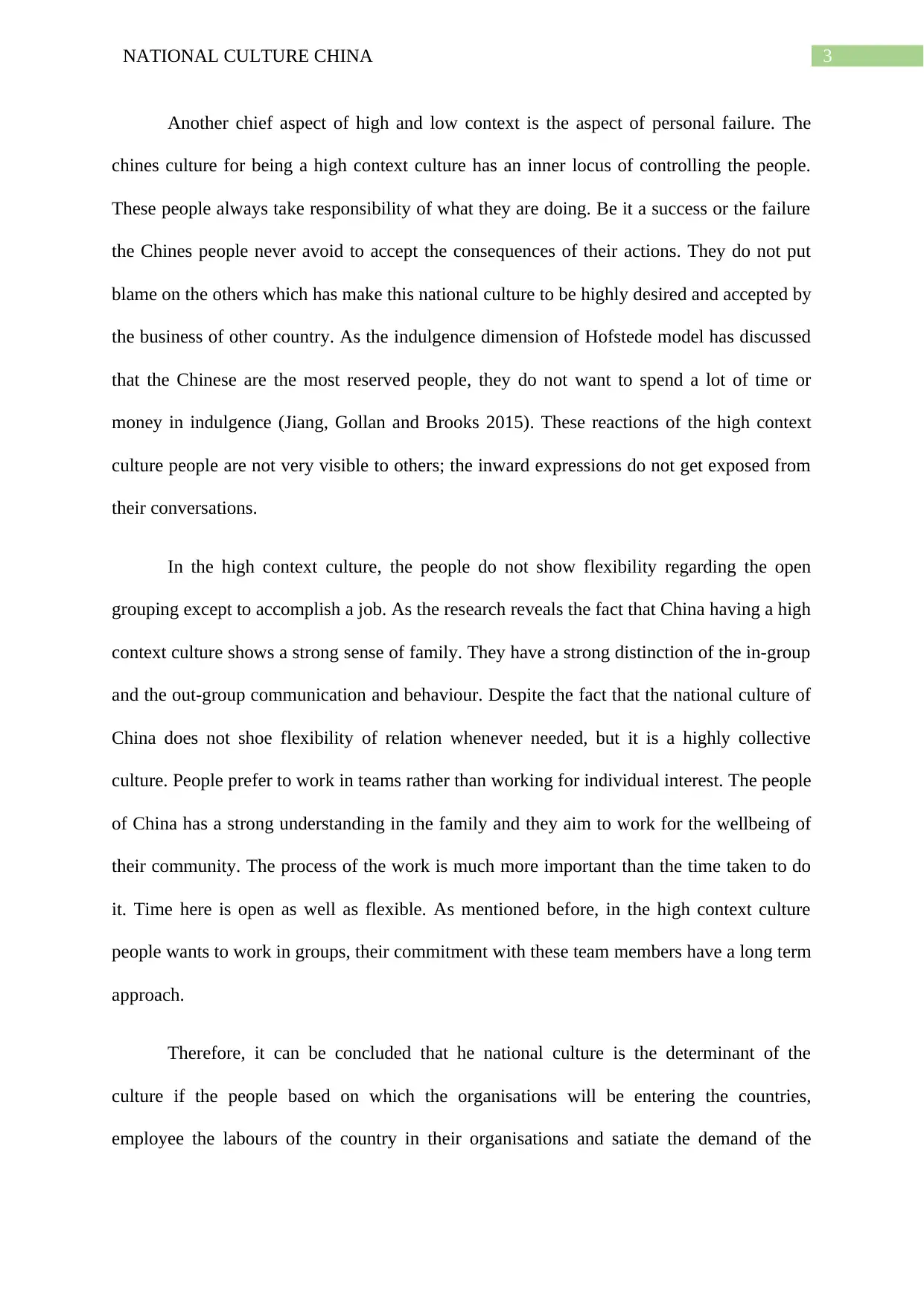
3NATIONAL CULTURE CHINA
Another chief aspect of high and low context is the aspect of personal failure. The
chines culture for being a high context culture has an inner locus of controlling the people.
These people always take responsibility of what they are doing. Be it a success or the failure
the Chines people never avoid to accept the consequences of their actions. They do not put
blame on the others which has make this national culture to be highly desired and accepted by
the business of other country. As the indulgence dimension of Hofstede model has discussed
that the Chinese are the most reserved people, they do not want to spend a lot of time or
money in indulgence (Jiang, Gollan and Brooks 2015). These reactions of the high context
culture people are not very visible to others; the inward expressions do not get exposed from
their conversations.
In the high context culture, the people do not show flexibility regarding the open
grouping except to accomplish a job. As the research reveals the fact that China having a high
context culture shows a strong sense of family. They have a strong distinction of the in-group
and the out-group communication and behaviour. Despite the fact that the national culture of
China does not shoe flexibility of relation whenever needed, but it is a highly collective
culture. People prefer to work in teams rather than working for individual interest. The people
of China has a strong understanding in the family and they aim to work for the wellbeing of
their community. The process of the work is much more important than the time taken to do
it. Time here is open as well as flexible. As mentioned before, in the high context culture
people wants to work in groups, their commitment with these team members have a long term
approach.
Therefore, it can be concluded that he national culture is the determinant of the
culture if the people based on which the organisations will be entering the countries,
employee the labours of the country in their organisations and satiate the demand of the
Another chief aspect of high and low context is the aspect of personal failure. The
chines culture for being a high context culture has an inner locus of controlling the people.
These people always take responsibility of what they are doing. Be it a success or the failure
the Chines people never avoid to accept the consequences of their actions. They do not put
blame on the others which has make this national culture to be highly desired and accepted by
the business of other country. As the indulgence dimension of Hofstede model has discussed
that the Chinese are the most reserved people, they do not want to spend a lot of time or
money in indulgence (Jiang, Gollan and Brooks 2015). These reactions of the high context
culture people are not very visible to others; the inward expressions do not get exposed from
their conversations.
In the high context culture, the people do not show flexibility regarding the open
grouping except to accomplish a job. As the research reveals the fact that China having a high
context culture shows a strong sense of family. They have a strong distinction of the in-group
and the out-group communication and behaviour. Despite the fact that the national culture of
China does not shoe flexibility of relation whenever needed, but it is a highly collective
culture. People prefer to work in teams rather than working for individual interest. The people
of China has a strong understanding in the family and they aim to work for the wellbeing of
their community. The process of the work is much more important than the time taken to do
it. Time here is open as well as flexible. As mentioned before, in the high context culture
people wants to work in groups, their commitment with these team members have a long term
approach.
Therefore, it can be concluded that he national culture is the determinant of the
culture if the people based on which the organisations will be entering the countries,
employee the labours of the country in their organisations and satiate the demand of the
Paraphrase This Document
Need a fresh take? Get an instant paraphrase of this document with our AI Paraphraser
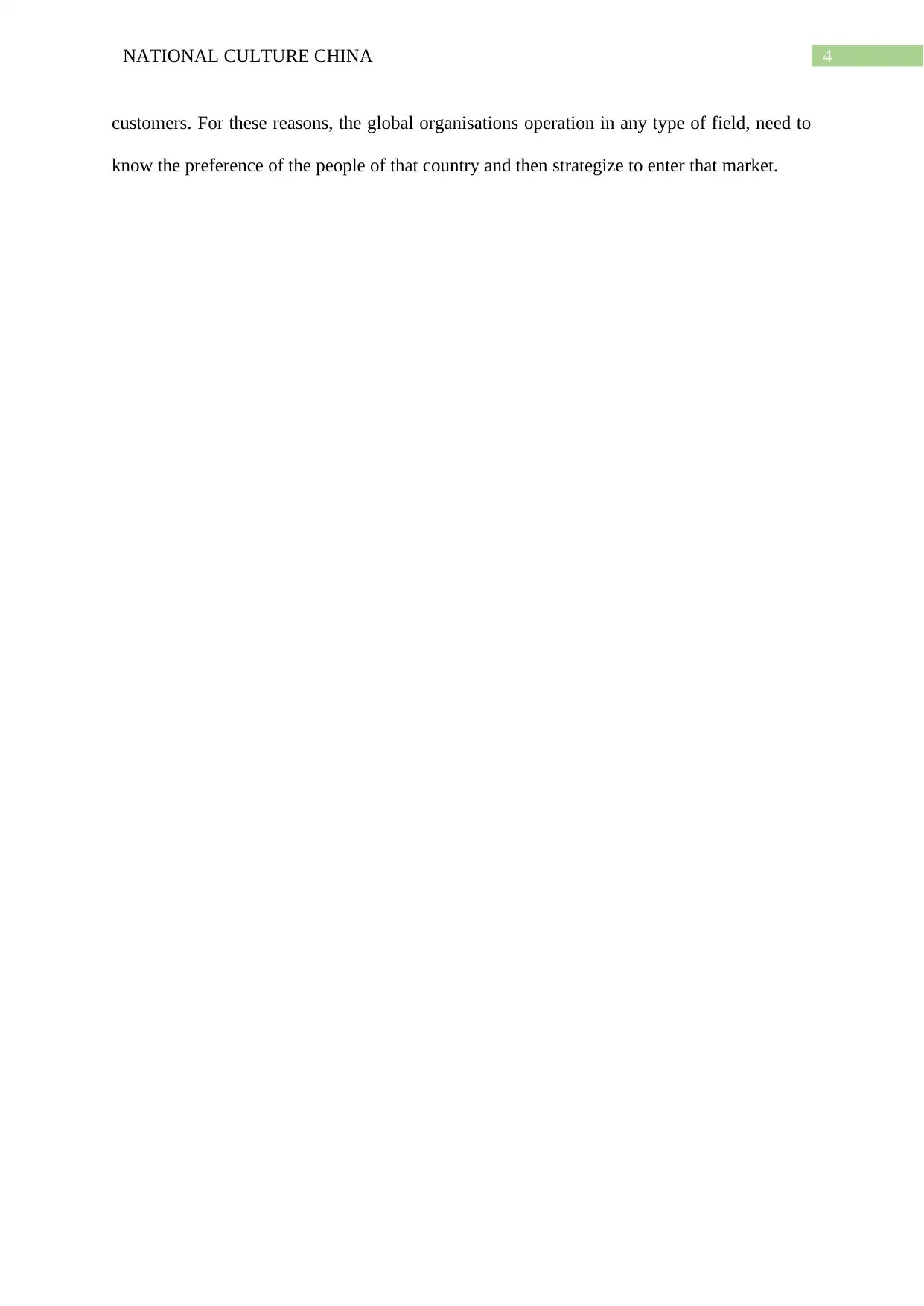
4NATIONAL CULTURE CHINA
customers. For these reasons, the global organisations operation in any type of field, need to
know the preference of the people of that country and then strategize to enter that market.
customers. For these reasons, the global organisations operation in any type of field, need to
know the preference of the people of that country and then strategize to enter that market.
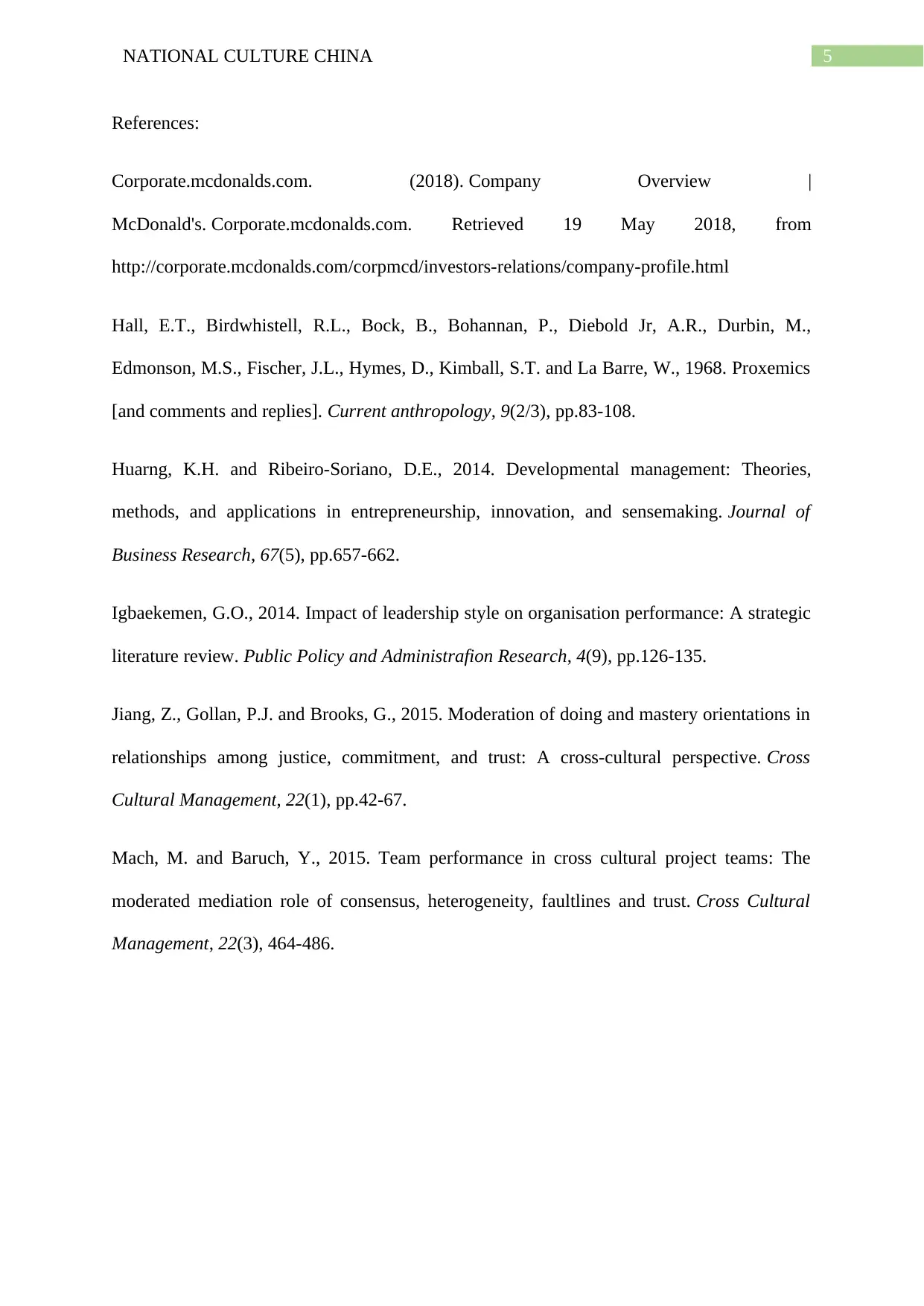
5NATIONAL CULTURE CHINA
References:
Corporate.mcdonalds.com. (2018). Company Overview |
McDonald's. Corporate.mcdonalds.com. Retrieved 19 May 2018, from
http://corporate.mcdonalds.com/corpmcd/investors-relations/company-profile.html
Hall, E.T., Birdwhistell, R.L., Bock, B., Bohannan, P., Diebold Jr, A.R., Durbin, M.,
Edmonson, M.S., Fischer, J.L., Hymes, D., Kimball, S.T. and La Barre, W., 1968. Proxemics
[and comments and replies]. Current anthropology, 9(2/3), pp.83-108.
Huarng, K.H. and Ribeiro-Soriano, D.E., 2014. Developmental management: Theories,
methods, and applications in entrepreneurship, innovation, and sensemaking. Journal of
Business Research, 67(5), pp.657-662.
Igbaekemen, G.O., 2014. Impact of leadership style on organisation performance: A strategic
literature review. Public Policy and Administrafion Research, 4(9), pp.126-135.
Jiang, Z., Gollan, P.J. and Brooks, G., 2015. Moderation of doing and mastery orientations in
relationships among justice, commitment, and trust: A cross-cultural perspective. Cross
Cultural Management, 22(1), pp.42-67.
Mach, M. and Baruch, Y., 2015. Team performance in cross cultural project teams: The
moderated mediation role of consensus, heterogeneity, faultlines and trust. Cross Cultural
Management, 22(3), 464-486.
References:
Corporate.mcdonalds.com. (2018). Company Overview |
McDonald's. Corporate.mcdonalds.com. Retrieved 19 May 2018, from
http://corporate.mcdonalds.com/corpmcd/investors-relations/company-profile.html
Hall, E.T., Birdwhistell, R.L., Bock, B., Bohannan, P., Diebold Jr, A.R., Durbin, M.,
Edmonson, M.S., Fischer, J.L., Hymes, D., Kimball, S.T. and La Barre, W., 1968. Proxemics
[and comments and replies]. Current anthropology, 9(2/3), pp.83-108.
Huarng, K.H. and Ribeiro-Soriano, D.E., 2014. Developmental management: Theories,
methods, and applications in entrepreneurship, innovation, and sensemaking. Journal of
Business Research, 67(5), pp.657-662.
Igbaekemen, G.O., 2014. Impact of leadership style on organisation performance: A strategic
literature review. Public Policy and Administrafion Research, 4(9), pp.126-135.
Jiang, Z., Gollan, P.J. and Brooks, G., 2015. Moderation of doing and mastery orientations in
relationships among justice, commitment, and trust: A cross-cultural perspective. Cross
Cultural Management, 22(1), pp.42-67.
Mach, M. and Baruch, Y., 2015. Team performance in cross cultural project teams: The
moderated mediation role of consensus, heterogeneity, faultlines and trust. Cross Cultural
Management, 22(3), 464-486.
⊘ This is a preview!⊘
Do you want full access?
Subscribe today to unlock all pages.

Trusted by 1+ million students worldwide
1 out of 6
Related Documents
Your All-in-One AI-Powered Toolkit for Academic Success.
+13062052269
info@desklib.com
Available 24*7 on WhatsApp / Email
![[object Object]](/_next/static/media/star-bottom.7253800d.svg)
Unlock your academic potential
Copyright © 2020–2025 A2Z Services. All Rights Reserved. Developed and managed by ZUCOL.





